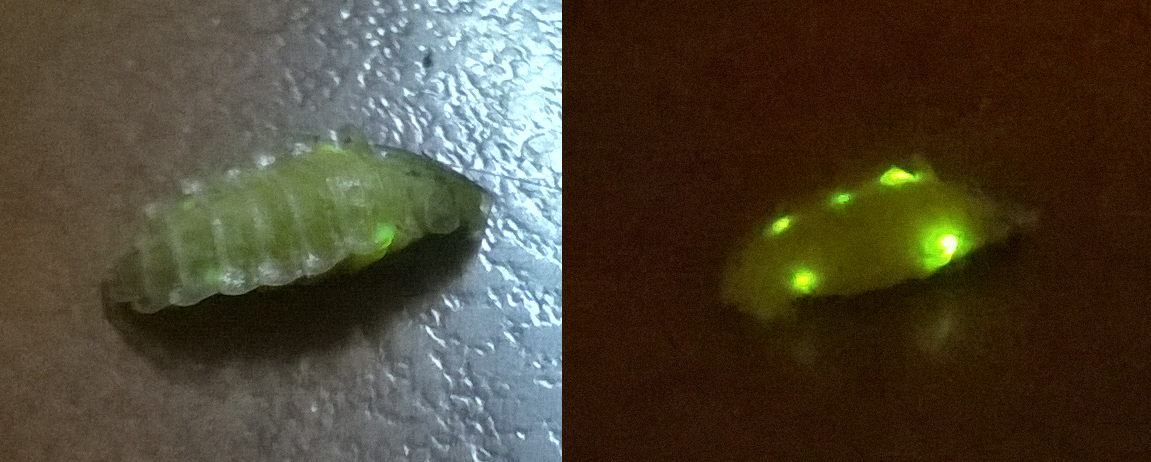Fireflies and introduction to bioluminescence

How is it possible for a living organism to produce light? You probably seen fireflies once in your life or at least heard about them. These tiny fellas roam the night and illuminate their surroundings with eerie yellow-greenish light.
We will cover what is bioluminescence and how does it work (in a chemical sense of speaking. I want to also introduce you to various types of fireflies that can be found around the globe as well as the reason why they utilize bioluminescence.
Btw, you need to listen to this while reading the article:
Yes, it is mandatory.
What is bioluminescence?
By definition it is the production and emission of light by living organisms. They usually do not do this just for fun but as a means of survival, propagation or even hunting. It is a production of so called “cold” light – that is because almost no heat is produced and almost all the energy (about 90%) is transformed to light. Just an interesting fact, in the case of light bulbs only about 10% of energy input is converted to light, with LEDs it is about 20%. Funny thing is that the majority of bioluminescent organisms are actually marine dwellers and our terrestrial bioluminescent organisms thus form only a fraction this group. Nonetheless we usually associate the term bioluminescence with fireflies.

Source
Biochemical basis of bioluminescence
Bioluminescence is basically conversion of chemical energy into light. The key compound is the so-called firefly luciferase – the name for the light-emitting enzyme. Luciferase catalyses the oxidation of luciferin in the presence of oxygen, magnesium cations and ATP. The reaction is a two-steps reaction as shown below.
2. luciferyl adenylate + O2 → oxyluciferin + AMP + light
Why does it actually produce light? Well, the reason for this is that the luciferin, or more specifically oxyluciferin is in an electrically excited state. Molecules do not like this and tend to release energy to return to ground state – and in this case a photon is being released. The main aim of luciferase is to propagate the dehydrogenation of luciferin. The quantum of produced light equals the number of oxidized molecules of luciferin.
The light emission is under control of central nervous system. The light is also emitted only by a special organ called photophore. In one experiment they cut of the head of the firefly. No light was produced. But when they stimulated respective neurons with electricity they were able to turn on the light – evidence that it is under the control of nervous system (a bit gross). These organs have specialized “muscles” that can regulate the flow of haemolymph (insect blood). It has been found that the decrease in flow of haemolymph results in decrease in bioluminescence.
Lightning bugs from all around the world
There are many kinds of fireflies in the world, so it is probably impossible to introduce all of them here. I am not going to focus on specific insects, but more on regions they live in and general description of fireflies living in such regions.
Fireflies from Central Europe - In these cases females are wingless and look a bit like worms. Males are winged and fly. Interesting thing is that they just shine, they do not exhibit any time-specific blinking. Bioluminescence is used as a means of reproduction. Females signalize their presence with light and males then find them.
Fireflies from North America - Here are both sexes winged and participate on mating rituals. They tend to group together on certain trees and blink asynchronously. There are usually more species of fireflies on one tree, thus the blinking frequency, colour of light and the height they fly in are crucial to determine whether they are from species or not.
Fireflies from Asia and Oceania Winged males tend to group together and sit on trees. They start to blink synchronously. This causes two things. 1. They attract more males from the jungle. 2. They attract females that then choose partner for mating.
I want to add this picture of probably female firefly from Slovakia that I took a few years ago. The light intensity is really something!

Purposes of bioluminescence
As mentioned already - mating.
Predation - some fireflies mimic the characteristic light signals of other species and lure them just to eat them. Nasty, but clever.
To scare away predators - bioluminescent species usually do not taste good. They taste so bad that the predator will remember such experience for a long time and next time will probably not eat anything that is bioluminescent.
Concluding remarks
I hope you did all learn something new today and listened to great song, haha. If you enjoyed this article, please support me with upvote or comment.
Have a nice day!
References:
Firefly luciferase
PHOTOBIOLOGICAL SCIENCES ONLINE
Etológia hmyzu (2012) - Milada Holecová - sorry in Slovak language
Thank you.. I loved it. I saw this paper btw Firefly bioluminescence quantum yield and colour change by pH-sensitive green emission This topic seems to be very interesting.
Thanks for the paper, will look into it! :) And I am happy that you enjoyed reading my article.
Bioluminescence is something that started my interest in light and biology and optogenetics, haha.
Being A SteemStem Member
nice posting
Interesting this subject, I had never asked how it is that fireflies do to appear bright, but I clarified it. Excellent, following you
Thank you and I am glad that you liked it! :)